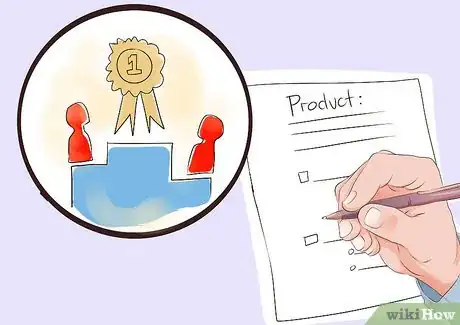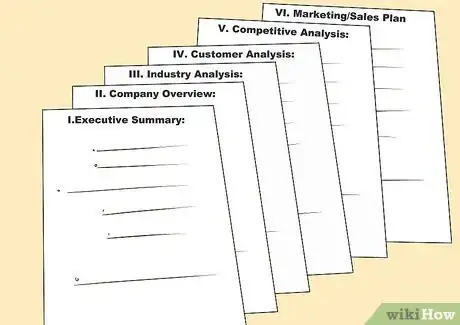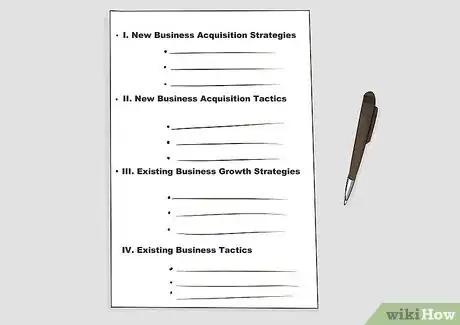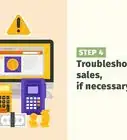This article was co-authored by Michael R. Lewis and by wikiHow staff writer, Christopher M. Osborne, PhD. Michael R. Lewis is a retired corporate executive, entrepreneur, and investment advisor in Texas. He has over 40 years of experience in business and finance, including as a Vice President for Blue Cross Blue Shield of Texas. He has a BBA in Industrial Management from the University of Texas at Austin.
wikiHow marks an article as reader-approved once it receives enough positive feedback. This article has 17 testimonials from our readers, earning it our reader-approved status.
This article has been viewed 463,381 times.
When your business is sales, many of the factors that determine success are out of your control. Whether you are trying to develop an overarching guide to your sales business strategy, or are a salesperson seeking to define your goals and tactics for meeting (and exceeding) your targets, writing a sales plan can help you take a bit more control in the unpredictable world of sales.
Steps
Writing a Sales Business Plan
-
1Create an executive summary. Business plans — sales-oriented and otherwise — are often initially created by new enterprises that are seeking investors or financing, then revised over time. An executive summary is a standard way to quickly introduce the key details of your business. [1]
- The executive summary is the introduction to your business. It defines the problem or need in the market, and explains how you are uniquely capable of solving / providing for it. It tells people unfamiliar with your business what you do and why you will succeed.
- It should also touch on your marketing, financial, and management strategies, and projections for your business going forward. Essentially, it should provide a “taste” of the information included in the business plan as a whole.
- Take, the “summary” part seriously, though. It should be brief, at most a couple of paragraphs. It is also acceptable to use bullet points, graphics, or other means to making the key points clear and accessible. You want those outside the field to clearly understand it.
-
2Define your business and product. After the executive summary, your sales business plan will need to flesh out the details in that initial section. It is smart to begin by providing more information on who your are and what you sell.
- Provide brief details on when and how your business was formed, where it is located, and its legal structure (sole proprietorship, LLC, etc.).
- Define the value of your product or service. Identify the unique and specific benefits your product or service provides for your target population. Your product may save people money, improve their health or advance their knowledge. Clarify the exact need that you are meeting.
Advertisement -
3Analyze your industry. Once you’ve explained who you are and what you do, you need to identify the other players in your field and your relative position among them. What other companies sell the products or services you do? [2]
- Establish your position in the market. Determine the exact niche for your product or service. Your product may be an innovative tool for solving a common problem in a particular demographic. Or it may be similar to other products, yet more affordable for a specific demographic.
- If you provide small-business IT services, for instance, you want to provide an overview of the larger industry and any ongoing or likely changes within it.
- Consider the trends in your industry and market in order to project your future growth or success (hopefully) moving forward.
- Consider the geographic limits of the market area. Service companies in particular are often disadvantaged by higher costs of travel to extended areas versus local competitors.
-
4Consider your customers. In this section of the sales business plan, you want to zero in on the target demographics for your products or services. Who do you sell to (or want to sell to), and how many of “them” are there in your market?[3]
- If you sell relaxing bath products, for example, you target population may be working mothers between ages 25 and 49. Provide brief demographic and geographic information, along with projections moving ahead.
-
5State your competitive advantage. Once you have identified who you are, what you sell, who you sell it to, and who else is doing the same, you need to establish specific reasons why you will succeed. Whether it is to lure investors or provide a vision for your sales business, you need to express justifiable confidence in your position.[4]
- If, say, you are a regional snack-food producer, you should outline the strengths and weaknesses of your main competitors, and delineate why you have (or will have) the upper hand. It could be an innovative product line, marketing strategy, distribution technique, pricing model, and so on.
- Be realistic in your analysis, but don’t be shy to state why you will “win.” Now is not the time for modesty.
-
6Lay out your sales and marketing plans. This section is particularly vital for a sales-oriented business. You have just explained why you are going to “win,” and now you need to describe how.[5]
- Examine your pricing structure. Writing a sales plan is an opportunity to establish a pricing strategy. Research similar products and services in the industry and set prices accordingly. Prices should allow you to remain competitive and still generate profits. Include plans for incremental price increases in line with manufacturing costs.
- Outline your long-term and short-term revenue goals. Be as realistic as possible in your forecast. Use your recent revenue history as a guide, accounting for significant changes in the market that may decrease your revenue or create new opportunities in the future.
- Identify ideal locations for your products and services. Opening a new store location and making your products available to resellers are possible options. Your sales plan should include where all of your sales activity will take place and the costs associated with each location.
- Define your advertising approach. Websites, print publications, television advertising and banners are a few advertising options. Evaluate the performance of each marketing strategy throughout the history of your business and include the successful options in your marketing plan.
- Outline the activities of your sales and marketing team. Include the sales strategies that have proven effective in the past. Cold calling, attending trade shows and partnering with organizations are examples of sales and marketing activities. Describe the approach that your sales team will use both in the short-term and long-term to generate leads and close deals.
-
7Put it all together. Truth be told, there is no single standard format for a sales business plan. Generally speaking, the content is more important than the style. That said, there are some common ways of laying out your plan.
- This is not an essay, so, as mentioned, bullet points, graphics, tables, and the like can be used to provide key information succinctly and explicitly. Try to keep a consistent style for readability.
- Some may extol the virtues of the one-page sales business plan,[6] but if you find that this is too restrictive, don’t fret. There is no real standard for length either, although brevity is indeed valued.
- Break down your plan into clearly-titled sections. Here is one example of section headings to consider:
- I. Executive Summary; II. The Business and Its Products / Services; III. Industry Analysis; IV Customer / Market Analysis; V. Competitive Analysis
- Alternatively, you could also consider the following, which may be even more appropriate for a sales business:
- I. Executive Summary; II. Company Overview; III. Industry Analysis; IV. Customer Analysis; V. Competitive Analysis; VI. Marketing / Sales Plan
Writing an Individual Sales Plan
-
1Consider what you can do to reach your sales target. Every salesperson has a sales target he or she is expected to meet. In all honesty, practically every salesperson has a sales target he or she is expected to exceed. Creating an individual sales plan helps define the strategies and tactics that will be utilized to meet and exceed the target.[7] [8]
- Start your plan by establishing your sales target — weekly, monthly, yearly, or otherwise — and then outline several overarching strategies that you will use to achieve it.
- Strategies for enhancing sales might include increasing awareness in the community, obtaining more referrals from existing customers, or adding to your number of weekly “cold calls” to potential customers.
-
2Define your tactics for increasing sales. If the strategies you lay out are your general guidelines, then the tactics you describe are the specific ways in which you will make more sales.[9]
- For instance, if one of your strategies is to increase community awareness, your tactics may include attending a set minimum of community events and volunteering at least so many times per month / quarter / year in the community.
- If one of your tactics is to enhance your social media presence, you should provide specific details. For instance, how many social media posts do you intend to average per day?[10]
-
3Determine how you will stay relevant to current customers. For many engaged in the sales business, holding onto current customers is as vital as recruiting new ones. Here again, you want to begin by laying out some key strategies that you will employ, then add some specific tactics which you will utilize.[11] [12]
- One strategy, for example, may be to increase your opportunities for at least monthly interaction with each of your existing clients.
- If so, your tactics could include calling once per month with a relevant idea or tip, setting up an interactive newsletter, or taking a minimum number of existing clients to lunch per month.
-
4Explain how you will “prospect” within your existing customer base. Obviously you want to at minimum retain your existing sales with existing clients. Even better, however, is to mine this fertile ground for increased sales with existing clients and new sales to additional clients.[13] [14]
- Your strategies here could in fact be listed as “increase sales within my existing client base” and “identify new clients through my existing client base.”
- Your tactics could include meeting with the key decision-maker for every account you hold, scanning client social media outlets daily for useful news, or including promotional materials with every delivery of goods or services.
-
5Lay out your individual sales plan. Individual sales plans should be brief, and generally shorter than sales business plans. One page is a reasonable length. For clarity and convenience, straightforward subject headings and succinct, specific bulleted points are recommended.[15]
- Simple and direct is key. You want something you, your boss, or anyone else who wants to look can scan quickly and understand. Think of it as something you can (and may actually want to) post on a bulletin board.
- Simple and direct plans are also easier to revise as times and circumstances change. You should indeed revisit and revise your individual sales plan regularly.
- Consider the following example for four possible subject headings for an individual sales plan. Each section would include three to five bulleted strategy or tactic examples:[16]
- I. New Business Acquisition Strategies
- II. New Business Acquisition Tactics
- III. Existing Business Growth Strategies
- IV. Existing Business Growth Tactics
References
- ↑ http://www.wahm.com/articles/how-to-write-a-one-page-sales-business-plan.html
- ↑ http://www.wahm.com/articles/how-to-write-a-one-page-sales-business-plan.html
- ↑ http://www.wahm.com/articles/how-to-write-a-one-page-sales-business-plan.html
- ↑ http://www.wahm.com/articles/how-to-write-a-one-page-sales-business-plan.html
- ↑ http://www.wahm.com/articles/how-to-write-a-one-page-sales-business-plan.html
- ↑ http://www.wahm.com/articles/how-to-write-a-one-page-sales-business-plan.html
- ↑ http://www.businessbee.com/resources/sales/analytics-reporting/creating-a-successful-sales-plan-4-important-questions-to-ask-yourself/
- ↑ http://www.entrepreneur.com/article/69864
- ↑ http://www.entrepreneur.com/article/69864
- ↑ http://www.businessbee.com/resources/sales/analytics-reporting/creating-a-successful-sales-plan-4-important-questions-to-ask-yourself/
- ↑ http://www.businessbee.com/resources/sales/analytics-reporting/creating-a-successful-sales-plan-4-important-questions-to-ask-yourself/
- ↑ http://www.entrepreneur.com/article/69864
- ↑ http://www.entrepreneur.com/article/69864
- ↑ http://www.businessbee.com/resources/sales/analytics-reporting/creating-a-successful-sales-plan-4-important-questions-to-ask-yourself/
- ↑ http://www.businessbee.com/resources/sales/analytics-reporting/creating-a-successful-sales-plan-4-important-questions-to-ask-yourself/
- ↑ http://www.entrepreneur.com/article/69864
About This Article
Start a business sales plan with a summary of the problem your business is solving. Add details about when your business was formed and what its legal structure is. Establish your position in the market relative to other, similar businesses, and then define your target demographic and potential customers. Include information about why your business in particular will succeed. Finally, include a section about your sales and pricing strategies. For advice from our Financial reviewer about how to write an individual sales plan, read on!


































































